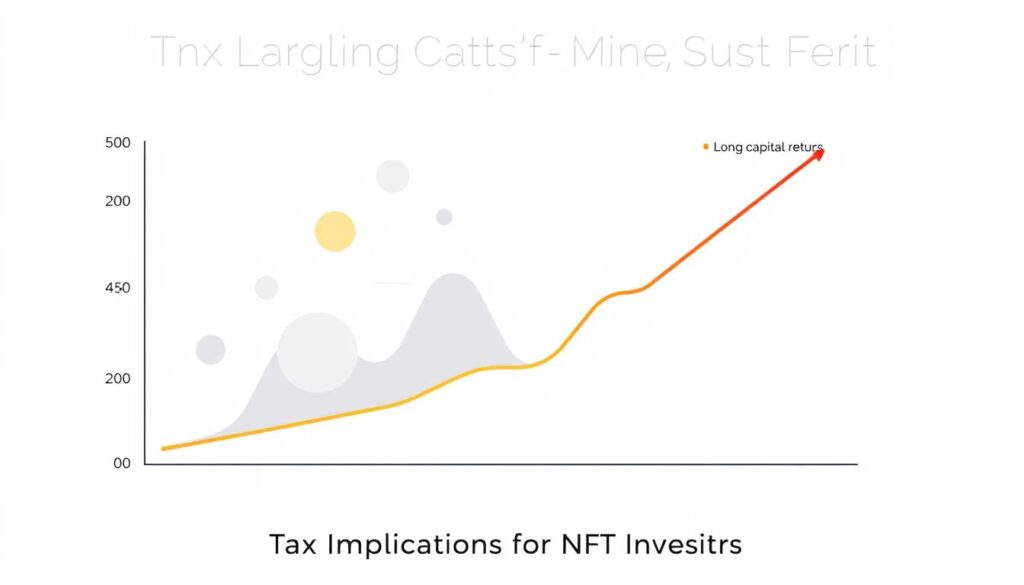Now Reading: NFT Tax Reporting Capital Gains: Essentials for US Investors
- 01
NFT Tax Reporting Capital Gains: Essentials for US Investors
NFT Tax Reporting Capital Gains: Essentials for US Investors

The digital landscape has witnessed a remarkable transformation in recent years. Unique digital collectibles have evolved from niche curiosities into mainstream investment opportunities. This shift brings new financial responsibilities that American participants must understand.
Government authorities are paying closer attention to transactions involving these digital assets. The Internal Revenue Service has implemented stricter reporting requirements for everyone involved. Both casual collectors and professional creators face the same compliance standards.
This comprehensive guide explores the essential aspects of financial compliance for digital asset transactions. We’ll cover everything from basic calculations to advanced planning strategies. Understanding these requirements helps investors avoid potential penalties and legal complications.
Proper documentation and accurate record-keeping form the foundation of successful compliance. Our resource addresses perspectives from various participants in this evolving market. Whether you’re buying, selling, or creating digital assets, this information proves invaluable.
Key Takeaways
- Digital collectibles have become mainstream investments requiring financial compliance
- American tax authorities are increasing scrutiny of digital asset transactions
- Both casual collectors and professional creators face reporting obligations
- Accurate record-keeping is essential for avoiding penalties
- This guide covers strategies for investors and creators alike
- Understanding compliance requirements protects against legal complications
- Proper documentation forms the foundation of successful financial reporting
Introduction to NFTs and Digital Assets
Digital collectibles have revolutionised how we perceive ownership in the virtual realm. These unique cryptographic items represent a new class of property rights.
Defining NFTs and Their Unique Characteristics
Non-fungible tokens are distinctive digital assets that certify authenticity across various items. Unlike standard cryptocurrencies, each token possesses individual characteristics that make it irreplaceable.
These tokens cannot be divided into smaller units or exchanged on equal terms. Their metadata contains permanent records of originality and transaction history.
The Rise of NFTs in the Digital Economy
The 2021 crypto market surge brought significant attention to profile picture collections. Projects like Bored Apes and Crypto Punks became cultural symbols with dedicated communities.
Blockchain technology enables this ecosystem through smart contracts on networks like Ethereum. Common standards include ERC-721 for singular items and ERC-1155 for semi-fungible tokens.
Applications span digital art, gaming assets, virtual real estate, and collectible trading cards. The transparent ledger ensures permanent, verifiable ownership records for all participants.
The Basics of NFT Taxation
The Internal Revenue Service has established clear guidelines for how digital assets are treated for financial purposes. American collectors need to understand these rules to maintain compliance.
Understanding IRS Classification of Digital Assets
The IRS categorises non-fungible tokens as property rather than currency. This classification aligns them with other cryptocurrencies like Bitcoin.
In March 2023, the agency announced it might treat certain digital collectibles as traditional collectibles. This could subject some holdings to higher rates reaching 28%.
The IRS employs a “look-through analysis” to determine proper classification. This method examines what the token actually represents against specific categories.

For example, an item representing physical art or gems qualifies as a collectible. Virtual land in digital environments typically receives standard treatment instead.
How NFT Transactions Trigger Taxable Events
Many investors mistakenly believe blockchain activity remains private. The transparent ledger actually makes all movements traceable by authorities.
The IRS collaborates closely with cryptocurrency exchanges that collect user information. These platforms report significant trading data to enhance enforcement capabilities.
Any exchange involving digital property creates reporting obligations. Using cryptocurrency to acquire collectibles or trading between tokens both qualify as taxable events.
NFT tax reporting capital gains: A Buyer’s Guide
When engaging with unique digital assets, investors face specific financial calculations that determine their obligations. Each transaction creates potential financial events that require careful documentation.
Understanding these processes helps collectors maintain proper compliance with current regulations. The foundation lies in grasping how profits from digital asset transactions are calculated.
Capital Gains Explained for NFT Investors
Purchasing digital collectibles using cryptocurrency creates an immediate financial event. You effectively dispose of that crypto, which may trigger obligations on any appreciation.
For example, using 100 ETH to acquire a Crypto Punk when ETH trades at $3,000 creates a total value of $300,000. If you originally obtained that ETH at $1,000 per token, you face calculations on the $200,000 increase.
Selling your digital assets also generates financial considerations. The difference between your cost basis and sale proceeds determines your potential liability.
Consider buying a Milady item for 5 ETH when ETH was $2,000. Your cost basis becomes $10,000. Later selling for 4 ETH when ETH reaches $4,000 gives you $16,000 in proceeds.
This results in a $6,000 gain despite receiving fewer tokens. Tracking both acquisition and disposal values in fiat terms is essential for accurate calculations.
Cryptocurrency volatility significantly impacts these determinations. Proper documentation forms the foundation for all subsequent compliance requirements.
Reporting Requirements and IRS Guidelines
American investors now face specific documentation obligations when dealing with blockchain-based collectibles. The Internal Revenue Service has implemented structured protocols for these activities.
Understanding the proper forms and recordkeeping practices is essential for compliance. This guidance helps ensure accurate submissions.
Essential IRS Forms and Their Functions
Starting in 2025, brokers must issue Form 1099-DA for digital asset activities. This document includes critical transaction details like dates and proceeds.
The form helps authorities verify the accuracy of taxpayer submissions. It represents a significant advancement in compliance standards.

Investors use Form 8949 to list individual sales and calculate gains or losses. Schedule D then summarises these results for the annual submission.
These documents work together to create a complete financial picture. Proper completion ensures compliance with current regulations.
Recordkeeping and Transaction Documentation
The definition of a digital asset broker now includes various platforms. Centralised marketplaces and certain decentralised services must collect user information.
Brokers face penalties for incorrect or missing documentation. However, investors maintain ultimate responsibility for their tax return accuracy.
Meticulous personal records are essential for defending positions during reviews. Documentation should include dates, amounts, and relevant wallet details.
This independent recordkeeping provides crucial support for all reported transactions. It forms the foundation of proper compliance.
Tax Implications for NFT Investors
The duration an investor holds their digital property significantly impacts their financial obligations. Understanding these timing distinctions helps optimise investment strategies and minimise liabilities.
Short-Term versus Long-Term Gains
Digital assets held for less than twelve months qualify as short-term holdings. Profits from these disposals align with ordinary income brackets.
These rates can reach up to 37% for high-earning individuals. The classification depends entirely on the calendar period of ownership.

Items retained beyond one year receive preferential treatment. Long-term capital gains rates offer substantial savings opportunities.
Most taxpayers benefit from a maximum 20% rate under this category. However, special collectible classification may apply a 28% ceiling instead.
| Holding Period | Classification | Maximum Rate | Key Factors |
|---|---|---|---|
| Under 1 year | Short-term | 37% | Ordinary income brackets |
| Over 1 year | Long-term | 20% | Total taxable income |
| Over 1 year (collectibles) | Long-term special | 28% | Asset classification |
Multiple elements influence the final calculation. Your annual earnings level and the specific asset characteristics both matter.
Strategic timing can create meaningful financial advantages. A thirteen-month holding period instead of eleven months demonstrates this principle clearly.
Tax Implications for NFT Creators
Individuals who generate digital collectibles encounter specific obligations that hinge on their professional status. The distinction between casual enthusiasts and serious business operators fundamentally alters how these activities are treated.

Minting, Selling and Earning Royalties
Creating a digital asset typically involves minting fees paid in cryptocurrency. When you use crypto to cover these costs, that disposal constitutes a taxable event.
The Internal Revenue Service examines whether your activities qualify as a hobby or business. Casual creators generally face capital gains treatment on sales. Professional operators must treat their digital items as inventory.
For those running a legitimate enterprise, profits constitute self-employment income. This classification triggers additional obligations beyond standard income tax. Business expenses may be deductible against this revenue.
Royalty payments present particular complexity under current guidance. Ongoing earnings streams likely qualify as ordinary income for professional creators. One-time payments might receive different treatment.
| Aspect | Hobbyist Creator | Professional Creator |
|---|---|---|
| Primary Activity | Recreational creation | Business operation |
| Income Classification | Capital gains | Self-employment income |
| Additional Taxes | Standard rates apply | Self-employment tax applies |
| Royalty Treatment | Possible passive income | Ordinary income likely |
| Expense Deductions | Limited options | Business expenses deductible |
Proper classification requires careful consideration of your actual circumstances. Mischaracterisation can lead to compliance issues or missed opportunities. Consulting a qualified professional ensures accurate reporting.
Calculating NFT Taxes and Cost Basis
Accurate calculation of your financial obligations begins with establishing the correct cost basis for each digital asset transaction. This foundational figure determines your final profit or loss when you dispose of an item.
Your total investment includes more than just the purchase price. Meticulous record-keeping of all associated expenses is crucial for an honest representation.
Incorporating Gas Fees and Transaction Costs
The cost basis is the total amount you invest in acquiring a digital collectible. It is not limited to the price paid to the seller.
Network gas fees paid in cryptocurrency to mint, buy, or transfer an item are a significant part of this calculation. These fees are added to your initial investment.
- Purchase price paid to the seller
- All blockchain network gas fees
- Any other directly associated transaction costs
By including these extra costs, you effectively lower your taxable profit when you sell. This can lead to substantial savings and ensures full compliance.
Using Form 8949 and Schedule D
For each sale, you must report the details on Form 8949. This form is where you list individual transactions and calculate your gains or losses.
Items classified as collectibles require special attention. Their long-term disposals are compiled separately to apply the correct 28% rate.
After completing Form 8949, the final totals are transferred to Schedule D of your annual return. This provides the overall summary for authorities.
Strategies to Optimise and Reduce NFT Taxes
Investors have several legal methods available to minimise their financial liabilities from digital asset transactions. Strategic planning can significantly impact your overall financial outcomes when dealing with these unique items.
Holding Period Benefits and Timing Sales
Keeping digital collectibles for over twelve months qualifies them for preferential long-term rates. This approach can substantially reduce your financial obligations compared to short-term disposals.
Timing your sales during years with lower overall earnings provides additional advantages. Deferring transactions to subsequent periods can help manage bracket thresholds effectively.
Leveraging Tax Loss Harvesting and Charitable Donations
Deliberately selling underperforming assets creates opportunities to offset other profits. This technique, known as loss harvesting, can reduce your taxable income by substantial amounts annually.
Donating appreciated items directly to qualified charities bypasses certain financial events entirely. This approach requires holding the asset for more than one year and provides potential deductions.
Using traditional currency for purchases instead of appreciated cryptocurrency avoids immediate disposal events. Combining these strategies creates comprehensive optimisation for your portfolio management.
Navigating NFT Transactions in the Era of Web3
Play-to-earn gaming represents a fundamental shift in how digital entertainment generates real economic value. Web3 technologies enable true digital ownership of in-game items.
Tax Implications in Play-to-Earn (P2E) Gaming
Traditional gaming contrasts sharply with P2E models. Players now earn real profits through battling, quests, and trading digital items. These activities create complex financial scenarios.
Most P2E game actions involve crypto-to-crypto exchanges. This means nearly every transaction can trigger financial obligations. Upgrading equipment or trading characters both qualify.
| Activity Type | Asset Treatment | Tax Event | Documentation Needs |
|---|---|---|---|
| Selling earned items | Capital asset | Gains calculation | Cost basis records |
| Gameplay rewards | Ordinary income | Value at receipt | Fair market valuation |
| Trading between assets | Like-kind exchange | Disposal event | Transaction timestamps |
| Staking participation | Investment activity | Periodic income | Reward documentation |
P2E participants face practical tracking challenges. They must document potentially thousands of micro-transactions. Determining fair value for illiquid items adds complexity.
Proper compliance systems are essential from the outset. Consulting professionals helps avoid unexpected obligations. Understanding these reporting requirements protects gamers from compliance issues.
Leveraging Technology for Accurate Tax Reporting
Managing digital asset finances presents unique challenges for American collectors. Tracking numerous activities across different platforms can quickly become overwhelming.
Manual methods involve searching through blockchain records and building complex spreadsheets. This process consumes significant time and is highly vulnerable to mistakes.
Benefits of Crypto Tax Software
Specialised platforms like Crypto Tax Calculator and Blockpit solve these problems. They automatically gather your crypto information from wallets and exchanges.
Their smart engines analyse each event to determine its implications. This automation ensures precise calculations for your final obligations.
The advantages of using dedicated software are substantial. It transforms a complex, manual task into a streamlined, accurate process.
| Aspect | Manual Method | Software Solution |
|---|---|---|
| Data Collection | Manual entry from multiple sources | Automatic import via API/CSV |
| Transaction Labelling | Investor must categorise each one | Software automatically labels activity |
| Error Risk | High potential for miscalculations | Minimal, with automated checks |
| Time Investment | Extensive hours required | Significantly reduced |
| Final Report | Self-compiled, risk of errors | CPA-approved, ready for filing |
These tools generate comprehensive reports ready for your annual submission. This saves both time and potential professional fees.
While there is an initial setup, the long-term benefits are invaluable. The accuracy gained and audit risk reduced make the investment worthwhile for active participants.
Conclusion
Navigating the financial responsibilities of digital collectibles requires a clear understanding of evolving regulations. This dynamic market offers great potential but demands serious compliance from all participants.
We’ve explored how obligations differ for hobbyists and professionals. The classification of your assets and activities directly influences your financial implications. Both investors and creators of nfts must grasp these distinctions.
Key financial rates were detailed, from short-term income brackets to long-term preferential treatments. Understanding your holding period is crucial for managing tax liabilities effectively.
Accurate reporting is not optional. Using the latest guidance and specialised software ensures precision. This information protects you from potential penalties.
Staying informed and maintaining meticulous records is your strongest defence. Consult with professionals who understand digital assets. Proactive management turns complexity into confidence for your financial future.
FAQ
How does the IRS classify my non-fungible tokens for tax purposes?
The Internal Revenue Service (IRS) currently treats these digital assets as property. This classification means that general tax principles applicable to property transactions govern your dealings with these collectibles. The specific nature of the asset, such as whether it is considered a personal collectible, can influence the final tax rates applied to any profits.
What constitutes a taxable event when I deal with digital collectibles?
A taxable event occurs whenever you dispose of your asset. This includes selling it for cryptocurrency like Ethereum or for traditional currency (fiat). Swapping one token for another, or even using it to purchase a different item, also counts as a disposal. Importantly, receiving an airdrop or earning royalties from a secondary market sale creates ordinary income that must be reported.
What is the difference between short-term and long-term gains on my investments?
The distinction lies in how long you hold the asset before selling. If you dispose of it within one year of acquisition, any profit is a short-term gain, taxed at your standard income tax rate. If you hold the asset for more than one year, the profit qualifies as a long-term gain, which typically benefits from lower tax rates, providing a significant advantage for patient investors.
How do I calculate the cost basis for my transaction?
Your cost basis is the original value of the asset, which includes the purchase price plus any associated acquisition costs. These costs can encompass blockchain network fees, often called gas fees, and other transaction charges. An accurate cost basis is critical for correctly determining your gain or loss when you eventually sell or trade the item.
Which forms do I need to complete for my tax return?
You will likely need to use Form 8949, Sales and Other Dispositions of Capital Assets, to detail each individual transaction. The totals from this form are then transferred to Schedule D of your Form 1040. For income received from activities like minting or earning royalties, you may need to report this on Schedule 1 as ordinary income.
Are there any strategies to legally minimise my tax obligations?
Yes, several strategies exist. Holding assets for over a year to benefit from lower long-term rates is a primary method. Tax loss harvesting, which involves selling underperforming assets to realise losses that can offset gains, is another common approach. Donating a appreciated digital asset to a qualified charity can also provide a tax deduction while avoiding capital gains tax on the profit.
How can technology assist with my tax reporting for these assets?
Specialised cryptocurrency tax software can be immensely helpful. These platforms can connect to your digital wallets and marketplaces via an API, automatically importing your transaction history. They then calculate your gains, losses, and income, and often pre-fill the necessary forms like Form 8949, saving you considerable time and reducing the risk of manual errors.















